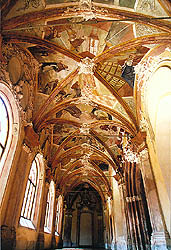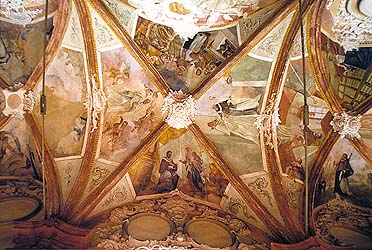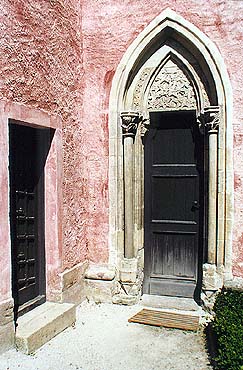Zlatá Koruna Monastery
 Address:
Address:
Státní vědecká knihovna
(State Scientific Library)
PhDr. Zdeněk Troup,
(monastery administrator)
Klášter Zlatá Koruna
381 01 Zlatá
Koruna
Telefon/Fax:
+420 380 743 126
Opening hours:
|
Apr. 1 - May 31 |
Tuesday - Sunday |
9.00 - 12.00 |
|
June 1 - Aug. 31 |
Tuesday - Sunday |
8.00 - 12.00 |
The last tour begins 60 minutes before the closing hour. The tours are guided and they are in the Czech language and according to the knowledge of the guide also in the main international languages. We can offer to our visitors from abroad the guided tour text in German, English, French and also in the Hungarian language. The permanent exhibition of "Literature in South Bohemia" can be seen in the monastery (it is without the guide). The reading room of the department of the manuscripts and the valuable prints is open to visit for the whole year in the monastery (Monday - Friday 9:00 - 15:00, tel. +420 380 743 132), the visit is possible after a booking.
Location:
The Zlatá Koruna monastery is located about 8 km to the north of
Český Krumlov, in the direction of České Budějovice.
Origin of the Name:
Přemysl Otakar II, the monastery founder, gave to it an alleged
thorn from the crown of Christ that was given to him by the French
king Louis IX the Saint. On Přemysl´s wish the monastery was named
after this relic the Holy Crown of Thorns (in the Latin language
Sancta Corona Spinea). It has been proven that in the beginning of
the 14th century the monastery was renamed Zlatá Koruna (Golden
Crown), probably in connection with the plentiful fortune of the
monastery. This popular name was also given to the village that was
founded near the monastery, but the monastery itself used still its
original name.

|

|
Description of the Place:
The monastery is situated on a headland that is surrounded from
three sides by the Vltava river. The monastery itself is enclosed
and the forecourt is annexed to it from the south-west side. The
forecourt is also enclosed with the walls. The architectural centre
of the monastery is formed by a convent church (a three-aisled
basilica with the transept) that is orientated almost to the north.
On the south side a convent with cloister is also annexed to it. On
the north of it the chapel of Guardian Angels is situated and the
so-called little convent is annexed to this chapel. Further on the
north buildings of the abbey and a brewery are situated. Its back
courtyard was accessible from the east or the west through the
Gothic gates.
Architectural and Historical Development:
The oldest preserved building is the one-floor chapel of Guardian
Angels dated around 1370. The chapel is with its style very close
to the oldest part of the church of the Vyšší Brod monastery. The
convent church was built step-by-step. Its plan could be partly
from the second half of the sixties or seventies of the 13th
century. Probably around 1278 the transept, the presbytery, the
later destroyed choir chapels and the northern part of the
three-aisled basilica up to the fourth couple of pillars, that were
supported the vault, began to be built. This constructional period
finished in 1320. The construction of the three-aisled church to
which the fourth nave was annexed on the north side, went on from
the second quarter of the 14th century until the beginning of the
second half of the 14th century. In 1359 Michal Parléř also
participated on this construction. The buildings of the convent
were built in several periods together with the church. Firstly the
north wing with a chapterhouse hall vaulted on two pillars was
built around 1300. This is a very significant demonstration of the
linear style. The construction of the convent was finished with the
construction of the well chapel in the middle of the 14th century
and it was annexed to the east part of the cloister.

|

|
The little convent is also built in the Gothic style. Its reconstruction and extension began at the beginning of the 17th century and it was finished in 1661. The Gothic buildings of the abbey were renovated at the end of the 16th and at the beginning of the 17th centuries. Later they were extended for a brewery. The only room that was preserved unaltered is the abbey chapel that is mentioned for the first time in 1387. The convent and the church were seriously devastated in 1420 and it became the reason for their Baroque reconstruction in the second half of the 17th century. At that time the church had a new vaulting, the annexed fourth nave was abolished and the north wing of the convent was extended to the east for a latrine building. In the second half of the 18th century the most of the interiors of the monastery were decorated with Rococo paintings (also painted by František Jakub Prokyš) and stucco.
When the monastery was abolished in 1785, it was bought by the Schwarzenbergs who rented it until 1909 for unsuitable industrial purposes. In consequences of that the monastery buildings were demolished and became dilapidated. For example the vaulted presbytery with the pentagonal plan of the chapel of Guardian Angels, the well chapel, the part of the north with of the convent did not survive those times. Also the Rococo decoration of the cloister was partly demolished. The monastery went through very exacting reconstruction during the forties of the 20th century.
In the forecourt of the monastery a number of buildings were preserved. Especially remarkable is the former church of Svatá Markéta (St. Margaret) from 1330 - 1340, the hospice, the salt-house and the mill.
The former abbey in Zlatá Koruna is the best preserved Cistercian monastery in Bohemia. The area of the monastery was in 1995 announced as the national cultural treasure.
Significant Architectural Features:
On the exterior side of the presbytery dated at the turn of the
13th and 14th centuries the components of the cathedral
architecture were used ("vimperky" - the Gothic decorative
ornaments - made on the rests, the pinnacles and the
gargoyles).

|

|
The wheel-window with richly carved work which is broken at an unusual place and that is situated in the north wall of the east wing of the transept, is probably the work of Michal Parléř. He is probably also responsible for the loose carved work on the portal in the southern front side of the church and the well chapel. The well chapel had a seven-sided plan and its vaulted ribs raising straight from the ground made a transparent skeleton. Through this skeleton a view of the ceiling itself was opened. This unusual vault expressed an artistic play.

|
The chapel of Guardian Angels has one floor and this is a phenomenon quite unusual within the Czech region. This chapel that is unusual within the Cistercian monasteries was most probably inspired by the court arts. We also can not exclude a connection with the one floor Sainte - Chapelle chapel situated in the royal palace in Paris. A thorn taken from the Crown of Christ was supposed to come from this place. Most probably the thorn is deposited in the chapel of Guardian Angels.

|

|
History of the Monastery's Residents:
The Cistercians of the most significant Austrian abbey in
Heiligenkreutz were called by Přemysl Otakar II to the Zlatá Koruna
monastery in 1263 for his support against power of the Witigonen
who built a powerful dominion in South Bohemia. The king presented
the monastery with huge estates that were significantly extended
with a present of Bavor ze Strakonic. The Witigonen soon put a stop
to the monastery's expansion and raided it and substantially
demolished it in 1276. However, another intensive construction of
the monastery was helped by the support of Václav II. During the
14th century the monastery went through its great prosperity and
about a hundred villages were founded within the monastery estates
during that time. The glory of the monastery faded in 1420 when it
was raided, demolished and burnt down by the Hussites. The monks
even left their home for some time. During the Hussite wars
 Ulrich
II. von Rosenberg took over all the estates and power of the
Zlatá Koruna monastery. The Rosenbergs did not give back the
estates and the situation around the monastery got worse at the end
of the 15th century. In 1493 the Czech king passed the Zlatá Koruna
estates to the Rosenbergs to their hereditary administration, so he
gave them literally all rights over those estates. The number of
monks slowly dwindled and their spiritual life became desolated. In
the middle of the 16th century the aristocratic patrons wanted to
abolished the monastery but it did not happen. Before the Thirty
Years' War the situation in the monastery got better and in the
second half of the 17th century under the rule of the abbot
Matěj Aleš Ungar it became one of the exemplary monasteries
within the Cistercian province of Český Krumlov. At that time the
controversy about a restitution of the monastery estates with the
Eggenbergs, the owners of the Český Krumlov estates, flared up
again. To defend the rights of the monastery several Cistercians
from Zlatá Koruna wrote a number works about its history. Those
works became valuable evidence for the historians of today (even
they can not be considered as objective). The long time lasting
discord continued even at the time of the Schwarzenbergs and was
not successful.
Ulrich
II. von Rosenberg took over all the estates and power of the
Zlatá Koruna monastery. The Rosenbergs did not give back the
estates and the situation around the monastery got worse at the end
of the 15th century. In 1493 the Czech king passed the Zlatá Koruna
estates to the Rosenbergs to their hereditary administration, so he
gave them literally all rights over those estates. The number of
monks slowly dwindled and their spiritual life became desolated. In
the middle of the 16th century the aristocratic patrons wanted to
abolished the monastery but it did not happen. Before the Thirty
Years' War the situation in the monastery got better and in the
second half of the 17th century under the rule of the abbot
Matěj Aleš Ungar it became one of the exemplary monasteries
within the Cistercian province of Český Krumlov. At that time the
controversy about a restitution of the monastery estates with the
Eggenbergs, the owners of the Český Krumlov estates, flared up
again. To defend the rights of the monastery several Cistercians
from Zlatá Koruna wrote a number works about its history. Those
works became valuable evidence for the historians of today (even
they can not be considered as objective). The long time lasting
discord continued even at the time of the Schwarzenbergs and was
not successful.
The last abbot of Zlatá Koruna Bohumír Bylanský (1755 - 1785) was an important person, who established the morality of the monks that had faded as the time went on. He also sorted out the economic situation of the monastery. He was interested in the new technology of agriculture and also in new products such as potatoes and mulberry trees. He paid attention to the planting of trees. Some of the monks were interested in the field of metrology and astronomy. A new exemplary school for the children of the serfs from the surroundings was founded in the monastery. ( School in Zlatá Koruna)
 But in 1785 the monastery
was deconsecrated by an order of emperor Josef II. The
Schwarzenbergs bought it and rented it to different businessmen
until 1909. So it happened that as time went on a silk factory, a
printed cotton factory, a cloth factory and at the end also a
machine factory and a foundry were there. The production of pencils
and a match factory were established in the also deconsecrated
church of St. Markéta. During the 19th century the monastery became
demolished and dilapidated. It went through a very exacting
reconstruction during World War II that literally saved the
monastery. In 1940 the Gestapo confiscated the monastery from the
Schwarzenbergs and it was confiscated again after World War II by
the state. Since 1979 it has been in the administration of the
State Scientific Library in České Budějovice.
But in 1785 the monastery
was deconsecrated by an order of emperor Josef II. The
Schwarzenbergs bought it and rented it to different businessmen
until 1909. So it happened that as time went on a silk factory, a
printed cotton factory, a cloth factory and at the end also a
machine factory and a foundry were there. The production of pencils
and a match factory were established in the also deconsecrated
church of St. Markéta. During the 19th century the monastery became
demolished and dilapidated. It went through a very exacting
reconstruction during World War II that literally saved the
monastery. In 1940 the Gestapo confiscated the monastery from the
Schwarzenbergs and it was confiscated again after World War II by
the state. Since 1979 it has been in the administration of the
State Scientific Library in České Budějovice.
Tales and legends:
According to the Baroque monastery chroniclers Přemysl Otakar II
founded Zlatá Koruna to thank God for blessing him in his victory
over the much stronger Hungarian king Béla IV in the battle of
Kressenbrunn. Although some fragmentary news taken from the sources
of that time as well as from later ones correspond with this
version, it was not the main reason why the monastery was
founded.
One big lime tree at the monastery courtyard was connected to a legend explaining the teardrop-shape of some its leaves. It is in remembrance of the monks who were hanged and killed there by the Hussites in the 15th century. The teardrop-shaped leaves are often on the lime trees and the reason for this is a kind of illness of that tree - a virus, that causes the concretion of the top parts of the leaves and forms a so-called scoop. Even the age of that lime tree does not correspond with those events because it was planted about 200 years ago.
An abbot of Zlatá Koruna was told that Wilhelm von Rosenberg, for whom the monastery built on his family's estates was like a thorn in his flash, made an emperor believe that the monastery was almost abandoned and nobody used it. An imperial officer was already on his way to the monastery to work out the situation. Before he came to the place, the abbot called all monks from neighbourhood, also his serfs from the villages together and clothed all of them in the priest's habits. He sat them to read the big Latin books and told them that nobody was allowed to speak not to reveal their lack of knowledge. The imperial officer saw everywhere the groups of monks reading the Latin books but he did not have any courage to ask anybody a question to hide his own ignorance. The reports he gave to the emperor were probably positive because the monastery of Zlatá Koruna remained safe and the Rosenberg´s struggles came to nothing.
Present use:
There are sightseeing tours of the monastery, the permanent
exposition "Literature in South Bohemia", the depository of the
State Scientific Library in České Budějovice, a dwelling place, a
private second-hand bookshop.
Further information:
Ecclesiastical History in the Český Krumlov Region
Vyšší Brod Monastery
(jh)







